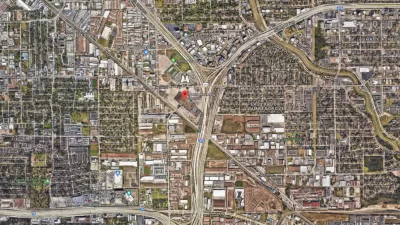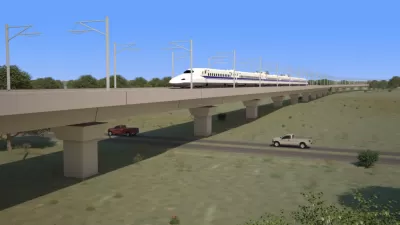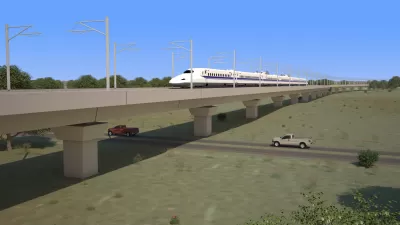A report commissioned by Texas Central Partners is the first to calculate the potential economic benefit of a proposed privately developed high-speed rail connection between Houston and Dallas.

Brandon Formby reports on the results of a study by Texas Central Partners about the potential economic benefit of a high-speed rail connection between Dallas and Houston. According to the study, as reported by Formby, "the project will spur $36 billion in economic benefits over 25 years – and will pour hundreds of millions of dollars into government coffers each year."
The private development of the project will bring unique benefits to public revenues. "Because Texas Central is a private company, its property and infrastructure is taxable, unlike tax-funded rail lines or highways. That means the company will have to pay property taxes to cities, school districts and counties for the entire length of its track between the two metropolitan areas. Those rural counties between the two cities is home to several people who oppose the project," explains Formby. In all, the report expects Texas Central to pay $2.5 billion in taxes by 2040.
The article also includes soundbites offered by Kyle Workman, president of Texans Against High-Speed Rail. Workman says the study overlooks the loss of property value on land taken along the route.
The article also includes more about forthcoming decisions about station locations.
Texas Central Partners hired Insight Research Group, based in Allen, Texas, to complete the study.
FULL STORY: Study: High-speed rail would spur billions in economic benefits

Trump Administration Could Effectively End Housing Voucher Program
Federal officials are eyeing major cuts to the Section 8 program that helps millions of low-income households pay rent.

Planetizen Federal Action Tracker
A weekly monitor of how Trump’s orders and actions are impacting planners and planning in America.

Ken Jennings Launches Transit Web Series
The Jeopardy champ wants you to ride public transit.

Rebuilding Smarter: How LA County Is Guiding Fire-Ravaged Communities Toward Resilience
Los Angeles County is leading a coordinated effort to help fire-impacted communities rebuild with resilience by providing recovery resources, promoting fire-wise design, and aligning reconstruction with broader sustainability and climate goals.

When Borders Blur: Regional Collaboration in Action
As regional challenges outgrow city boundaries, “When Borders Blur” explores how cross-jurisdictional collaboration can drive smarter, more resilient urban planning, sharing real-world lessons from thriving partnerships across North America.

Philadelphia Is Expanding its Network of Roundabouts
Roundabouts are widely shown to decrease traffic speed, reduce congestion, and improve efficiency.
Urban Design for Planners 1: Software Tools
This six-course series explores essential urban design concepts using open source software and equips planners with the tools they need to participate fully in the urban design process.
Planning for Universal Design
Learn the tools for implementing Universal Design in planning regulations.
Ada County Highway District
Clanton & Associates, Inc.
Jessamine County Fiscal Court
Institute for Housing and Urban Development Studies (IHS)
City of Grandview
Harvard GSD Executive Education
Toledo-Lucas County Plan Commissions
Salt Lake City
NYU Wagner Graduate School of Public Service





























